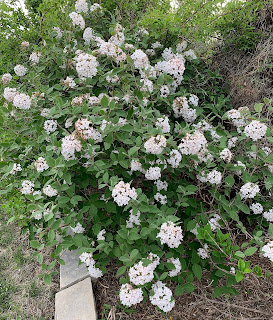 |
| 'Topaz Jewel', risen from the muck |
 In fact, my entire rose garden area is a swamp, a clay-based water basin of pure ooze. It is placed on a slight slope behind the house, but still, this morning, after an inch of rain Saturday and another 3/4's inch last night, you can see the water standing next to this bed right in front of 'Topaz Jewel' in the photo to the left. I planted a couple of new roses yesterday in a bed near here, slipping and sliding them into their designated spots, and found that if you dig a hole 6 inches deep anywhere in these garden beds, it will fill instantly with water. I will probably have nightmares tonight of all the rose roots screaming for oxygen in the yard while I helplessly listen to the storms forecast to visit once again. 'Topaz Jewel' and her immediate neighbors are at least in a raised berm, probably their only salvation at present.
In fact, my entire rose garden area is a swamp, a clay-based water basin of pure ooze. It is placed on a slight slope behind the house, but still, this morning, after an inch of rain Saturday and another 3/4's inch last night, you can see the water standing next to this bed right in front of 'Topaz Jewel' in the photo to the left. I planted a couple of new roses yesterday in a bed near here, slipping and sliding them into their designated spots, and found that if you dig a hole 6 inches deep anywhere in these garden beds, it will fill instantly with water. I will probably have nightmares tonight of all the rose roots screaming for oxygen in the yard while I helplessly listen to the storms forecast to visit once again. 'Topaz Jewel' and her immediate neighbors are at least in a raised berm, probably their only salvation at present. New roses are beginning to bloom this year, however, to fill in the gaps from RRD and to keep my hopes "afloat." The striped rose pictured at the right, in keeping with my switch to RRD-resistant Hybrid Rugosas and Old Garden Roses, was planted just last year, and today was the first bloom in my garden of Mr. 'Georges Vibert'. Mr. Vibert, or Georges as I will affectionately call him, is an 1853 Gallica bred by M. Robert of France. You all know my weakness for striped roses, and this one seemed like an obvious choice to fill in a gap in both my garden beds and in my soul. I'm hopeful for Georges continued health and vitality in my garden, especially since helpmefind/roses states that the Montreal Botanical Garden rated it as one of it's most disease resistant roses in 1998.
New roses are beginning to bloom this year, however, to fill in the gaps from RRD and to keep my hopes "afloat." The striped rose pictured at the right, in keeping with my switch to RRD-resistant Hybrid Rugosas and Old Garden Roses, was planted just last year, and today was the first bloom in my garden of Mr. 'Georges Vibert'. Mr. Vibert, or Georges as I will affectionately call him, is an 1853 Gallica bred by M. Robert of France. You all know my weakness for striped roses, and this one seemed like an obvious choice to fill in a gap in both my garden beds and in my soul. I'm hopeful for Georges continued health and vitality in my garden, especially since helpmefind/roses states that the Montreal Botanical Garden rated it as one of it's most disease resistant roses in 1998.I should finish by apologizing for being unable to resist the water-referencing puns I've "sprinkled" through this entry. Puns, though painful to the reader, are often, in my opinion, just one manifestation of a tormented writing soul, or, more specifically in my case, one "drowning" in an unusually wet season.






